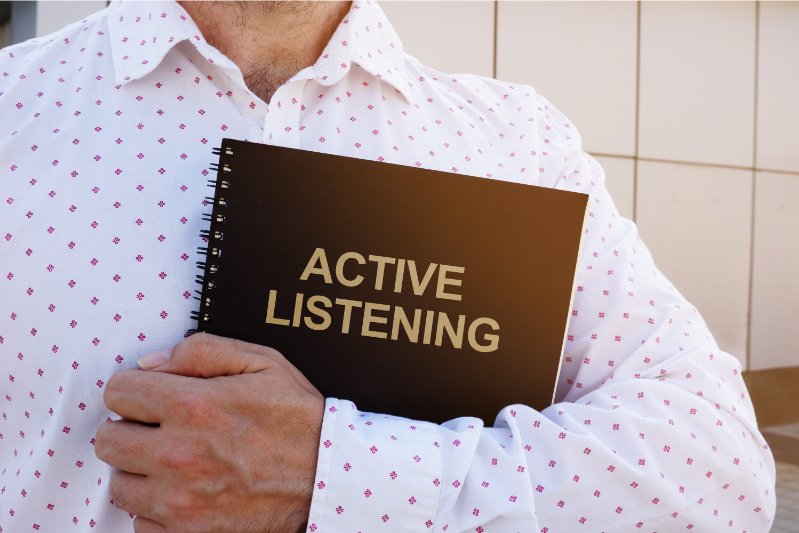When someone says, “Don’t just hear me, listen” they’re describing active listening (whether they know it or not). But, what’s the difference?
Hearing is an automatic mechanical function. It allows us to perceive and identify sound. And while listening often involves hearing, it’s only half of it.
Listening is our ability to process what’s being said. It’s our effort to understand the significance, tone, and impact of words. Active listening is beneficial for us and our relationships. It helps us understand people, make them feel heard, and ask for clarification when needed.
In this article, we’ll break down the process of active listening, step by step.
Step One – Pay Attention
Objective(s): To communicate readiness and willingness to listen.
Use verbal and non-verbal cues. Ex:
Verbal
- “I’m here to listen.”
- “Tell me about it.”
Non-verbal
- Make (culturally appropriate) eye contact
- Use open body language (face the speaker, smile/nod naturally)
- Maintain a calm attitude
- Focus on the speaker
- Try to limit distractions, internally and externally.
- Sometimes, we try to create responses in our head before someone is done speaking. We should be mindful of this, so it doesn’t distract us.
- Try to mute phone notifications, loud music, etc.
Step Two – Be Silent
Objective(s): To avoid interrupting the speaker and allow both parties time to process.
- Allow natural silences throughout the conversation. Remain silent for a few seconds after the speaker finishes to:
- Ensure speaker has finished talking
- Process what was said
Step Three – Paraphrase
Objective(s): To confirm that we’re listening and allow the speaker the opportunity to correct misunderstandings.
- Sum up what the speaker said in our own words. Be nonjudgmental and objective.
Step Four – Summarize
Objective(s): Confirm understanding.
- When they’re done speaking, re-state an overall summary of their main points. This is more or less in their words. This is just like when we summarize a book, movie, etc.
Step Five – Express Empathy
Objective(s): To demonstrate that we understand the emotional perspective of speaker. Below are examples for different scenarios (swap out the bolded words, depending on the situation).
- “That must be really frustrating /exciting for you.”
- “You must have felt scared / happy.”
Communication Blockers
These are common mistakes when it comes to active listening. Making them may bring the conversation to a stop.
Rescuing
- Tension reducers: Avoiding uncomfortable emotions by using humor to change the subject.
- Placating: Responding with unhelpful cliches (ex. “If at first you don’t succeed, try again.”)
Unsolicited Advice
Unsolicited advice undermines the speaker’s ability to determine what’s best for themselves. Typically, people already know the solution, and just need to talk.
However, it’s okay to ask if they want suggestions, and to provide advice if they ask.
Additional Stoppers
- Demanding others feel a certain way
- Telling people their emotions are right/wrong
- Minimizing feelings/experiences
- Asking the speaker to justify their feelings
Overcoming Listening Barriers
- Practice Patience. Allow people time to express their thoughts and feelings. Don’t rush them.
- Focus on trust. Create a warm, supportive environment.
- Don’t Assume. People relate to others based on their own frame of reference/life experience. We often assume we know how others feel or experiences things, but we don’t unless we listen to them.
- Control personal reactions, incl. emotional responses, facial expressions, other subjective responses.
- Understand that listening doesn’t mean we have to agree. Listen anyway.
- Be Self-Aware. Understand how personal values, beliefs and experiences could bias our thinking/feeling/responses.
Active listening is a learned skill. It’s okay if we’re not great at it initially. With time, we can provide a safe environment for our loved ones to freely express themselves. So, don’t just hear, practice active listening!

